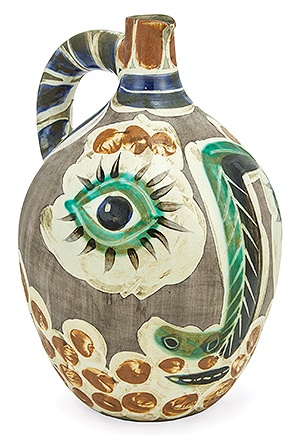Sublime Ceramics: Picasso’s Late Artistic Passion
04/20/2016 Prints & Multiples

Ceramics by Pablo Picasso provide a wonderful opportunity for collectors to purchase works of art by one of the most innovative, prolific and celebrated artists of the 20th century -- for a fraction of the price of his paintings. Indeed, Picasso welcomed the idea of making multiples from his unique ceramics, generally in editions of 50 to 500, pleased that they would be affordable to a wide audience.
While residing in the south of France in 1946 Picasso attended the first annual pottery exhibition in Vallauris. Picasso would later create several original posters to promote this annual event (lot 188). Though the village had a long history of pottery making dating back to Roman times, the craft there had been in decline. One of the exhibitors was the Madoura works owned by Georges and Suzanne Ramie. In 1936 they had purchased a complex of old buildings and a wood-fired kiln from a closed facility in Vallauris, where they produced plates and art pottery. Picasso became entranced by the Ramies’ pottery at the show, prompting a trip to their studio.
On his first visit to Madoura, he made three small objects: two bulls and the head of a faun. This experience made a strong impression on the artist, and he returned the following year with numerous drawings illustrating ideas he wanted to realize in ceramic form. The Ramies were delighted to welcome Picasso back, and provided him with an area in which to work. Though the artist had first worked in clay forty years earlier, it was not until he came to Madoura that the medium truly captured his imagination. Over the next 24 years, he created approximately 3,500 unique ceramic objects and authorized the Ramies to produce more than 633 numbered editions of his work.
Picasso embraced pottery-making with the same zeal he had for painting, drawing and printmaking, resulting in a prodigious creative output, characteristically pushing through preexisting boundaries. Many of the same themes he explored on canvas and paper he experimented with in clay, often playfully incorporating the three-dimensional nature of the medium into the design. For example, utilitarian pieces such as pitchers depicting faces are transformed into sculptural objects, the entire body of the pitcher metamorphosing into the face, with the handle becoming part of the hair (lots 205, 216, 217).
The face was one of Picasso’s most popular subjects in all artistic media, as illustrated by the drypoint, Profil de Femme, (lot 184); the lithograph, Tete de Jeune Fille (lot 185) and a variety of ceramics, including pitchers, plates, bowls and tiles. In some of the tiles, such as two entitled Masque from 1956 (lots 207 and 208), he belied the three-dimensionality of the medium, painting a flattened image of a face head on, on a square surface, suggesting a portrait on canvas or paper. Picasso explored this interplay earlier in plates such as Nature Morte a la Cuiller (lot 199), where he depicts a traditional painting subject, the still life, on a square dish. He created the image as he would an etching or drypoint, using a tool to carve the lines, but instead of an etching needle on metal, he used unconventional items such as a kitchen knife to cut into a plaster mold, which was taken from an existing piece of pottery. Impressions could thus be taken from the plaster matrix to create editions, referred to as Empreintes originales, and bearing the Empreinte Originale de Picasso Madoura pottery stamp.
Another favorite subject of the artist is the bullfight. As a child in Spain, Picasso regularly attended bullfights with his father, and the experience had a lasting effect on him. Fascinated with the ritual of manly valor and danger, and perhaps nostalgic for his childhood, he enjoyed attending bullfights again in the South of France. His cermic plates and pitchers frequently depict images of bulls and picadors, and in a plate of a bullfight scene (lot 212), the round form of the plate literally becomes the ring of the arena, in the center of which Picasso places the bull and a fallen picador.
In later years Picasso became increasingly interested in classical imagery, and thus the adoption in the 1940s of an injured owl, an animal associated with wisdom and a symbol of the Greek goddess Athena, stimulated his interest. The owl became a frequent subject of his ceramic vases and pitchers, as seen in Hibou, from 1954 (lot 204). The goat, another animal subject from antiquity, was also a popular motif, of which Tete de Chevre de Profil from 1952 (lot 194), is a wonderful example.
Created by Picasso late in his career, these extraordinary ceramic objects provide us with yet another glimpse into the artistic vision of one of the greatest artists of the 20th century.